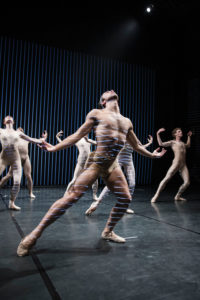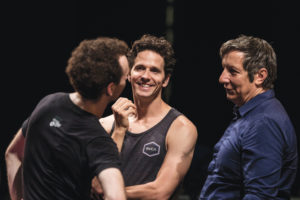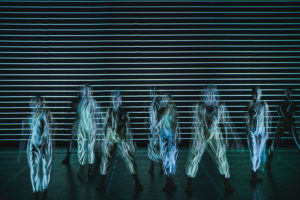Frame by Frame, Step by Step: Guillaume Côté discusses working with Robert Lepage to stage filmmaker Norman McLaren’s life and work - Vancouver Ballet Society
- Home
- Features 2015 - 2019
- Frame by Frame, Step by Step: Guillaume Côté discusses working with Robert Lepage to stage filmmaker Norman McLaren’s life and work

By Jenn Edwards
In a bright, spacious studio in downtown Toronto, choreographer Guillaume Côté leads a cast of 12 in a pragmatic rehearsal at the National Ballet of Canada headquarters. Huddled around a laptop, the dancers refresh their memories with footage of themselves from several months ago. It is January and they are stepping away from The Nutcracker back into something they’ve been working on in installments for about three years.
Today’s section of movement is about stop-motion technology. Using the space like a two-dimensional screen, one dancer snaps into position. The next dancer runs past him into a slightly more extended version of his shape. Then a third and a fourth extend their lines even further, like a human flip book.
Throughout this rehearsal, the dancers discuss musical timing, and the precise angles and incremental shifts of their shapes. Classical ballet steps are juxtaposed with pedestrian walking and athletic right-angled bodies. Their movements fall in and out of unison, phrases split off and converge with ease, and canons form and dissolve, all contained within a fast, mechanical sounding musical score by Antoine Bédard. There’s a momentum within the choreography that feels like a running filmstrip. The dance is both technical and technological.

Photo: Elias Djemil-Matassov
This is a glimpse into the creation of Frame by Frame, a collaboration between the National Ballet of Canada’s Côté (a principal dancer and, since 2013, a choreographic associate) and Quebec theatre director Robert Lepage. The full-length piece, which premieres in June, is inspired by the life and work of Canadian filmmaking legend Norman McLaren, who broke ground in the 1950s and 1960s with his work in animation and stop motion.
After the rehearsal, Côté explains that he first reached out to Lepage to collaborate about eight years ago, having been a self-proclaimed fan of his work from a young age. Intricate set design, lighting and projections are signatures of Lepage’s original plays, many of which he acts in himself. He has also brought his unique eye to the restaging of operas, and the work he wrote and directed for Cirque du Soleil, Kà, uses one of the most complex and expensive stage designs in the world.
“I wrote him a very nice email, and said I’d love to meet him,” says Côté. Eventually, the two did meet and, over several years, started brainstorming potential ways they could collaborate. Lepage came up with the idea of an homage to McLaren, and Côté jumped on board.
It seems that Côté has found a dream collaborator: “Robert is trying to see what I see and get into my brain as much as I’m trying to get into his.”
Research for Frame by Frame occurred over several years. Lepage always works in short installments, with breaks allowing for the rumination of ideas. Recounting the atmosphere of these workshops, Côté remarks, “Everything is exploration. And exploration is difficult for people like us.” He is referring to the fact that, typically, National Ballet of Canada dancers are busy learning and rehearsing a multitude of pieces at the same time, all of which require a high level of precision. Ballet dancers tend to live in a performance mindset, and there is a stigma in the classical world around the long creative processes more common to contemporary dance and theatre, which can look indulgent from the outside.
In fact, Côté describes the workshops with Lepage as “incredibly structured,” with “no wasting of time.” Bringing the cast from Toronto to Lepage’s workspace in Quebec City helped to calm nerves and open up the dancers to creative possibilities. “When we went there, suddenly everyone was more open to trying things. I think people surprised themselves.”
The show is intended to illuminate McLaren’s body of work, the mediums he worked in and some aspects of his personal life. Known as a quiet, somewhat introverted man, he created about 50 films and received more than 200 awards throughout his career. While he spent many years advancing the world of animation, he also made live action films such as the politically charged Neighbours (1952), for which he won an Academy Award. A critique on human attempts to solve problems with violence, it uses stop motion to depict two men brutally fighting over a flower growing on the property line between their perfectly manicured front yards.

Directed and produced by Norman McLaren
Photo: Taken from the production © 1968 National Film Board of Canada
One of the biographical scenes re-enacts the day McLaren met his partner of 50 years, Guy Glover (a National Film Board of Canada producer), at a ballet performance in Covent Garden. Other sections, focused on the work, are lifted directly from his films with the help of elaborate sets, lighting and costumes. Technical specialists from within Ex Machina, Lepage’s company, use digital technologies to recreate McLaren’s signature visual effects for the live stage.
Such interdisciplinary collaboration, says Côté, “creates boundaries. Some people believe that art should be as free as possible, but in order for an artist to really understand their craft, sometimes it’s a good thing to have limitations and borderlines.”
While choreographing, Côté has had to constantly consider external elements, including the complexities of the music, lighting and set pieces that will surround the dancers during performance, and, of course, the narrative Lepage is putting forward.
The choreography itself is also interdisciplinary, venturing at times into contemporary and jazz movements. This is in reference to the decades of cultural shifts McLaren lived through, and his vast musical knowledge that came through so strongly in animated films such as Begone Dull Care (1951), an abstract visual representation of jazz improvisations by Oscar Peterson.
McLaren’s work often draws entrancing connections between visual and auditory stimulation. This is due to a condition he had called synesthesia; listening to music caused him to see moving colours and shapes in his mind, which he often transposed to film by painting, drawing or carving directly on filmstrip. At 24 frames per second, this is meticulous and painstaking work, but McLaren enjoyed the process. He once said, “I try to preserve in my relationship to the film the same closeness and intimacy that exists between a painter and his canvas.” The resulting textures in his films are exquisite.
Côté also draws inspiration from some of McLaren’s more geometric work that came out of 1960s minimalism. “He was fascinated with simple lines and simple movement. Sometimes minimalist movements are really great; we don’t have to over-choreograph the show.”
Côté describes Lepage as an editor within the choreographic process, pushing certain scenes to become either more classical or more contemporary, and helping to clarify choreographic choices and “let go of things that are off track.” Lepage’s precise directorial style is well suited to ballet dancers. “He expects perfection, which is perfect for the National Ballet. Every dancer wants to know exactly which way they’re facing. He loves it.”

Photo: Elias Djemil-Matassov
While individual scenes from Frame by Frame have been workshopped extensively, the arc of the show will be finalized close to its premiere. This is due both to the company’s packed touring schedule and because many scenes rely on interactive projections and lighting that can only be ironed out in the performance space, Toronto’s Four Seasons Centre for the Performing Arts. Côté explains, “We have a lot of documentation of how the show is going to go, and a lot of choreography in chunks. We have 27 scenes that we know will make it in, we just don’t know how they will be linked.”
While flawless lines and timing are important, his main goal is to have audiences relate closely to the characters, which has always been a core component of Lepage’s compelling theatre. Artists from all disciplines may find inspiration in the filmmaker’s lifelong dedication to advancements in his field. But his love of many different art forms, including dance, is what makes the filmmaker’s life and body of work so special, and so relevant to the interdisciplinary way artists work today.
In his early years, McLaren was inspired by poetry, modern art and surrealist films. Later in life, he became fascinated by classical ballet. His dreamy 1967 film Pas de deux enhances choreography by Ludmilla Chiriaeff, using slow-motion capture and a kind of stroboscopic effect to leave trails of movement behind the dancers. In the 1990 documentary, Creative Process: Norman McLaren, he states that if he had been exposed to ballet as a child, he might have become a choreographer. As Côté observes, “McLaren’s work is very choreographic. Animation is choreography without the limitations of physical bodies.”

Photo: David Leclerc
